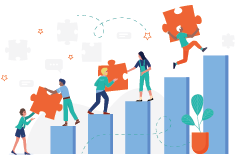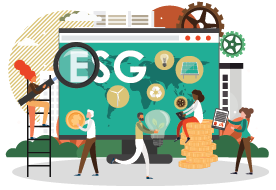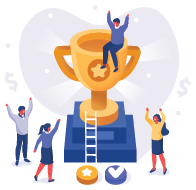By Karen Owen, SCMP, Vice President, Supply Management and Customer Relations, OECM
Abstract
Recent global events and the resulting fallout have accelerated organizations’ need to embrace change while bringing new priorities into focus. Pre-pandemic learnings and procurement trends – the need for continuous evolution through disruptive and collaborative procurement, the value of strong Customer Relationship Management (CRM) tools, rigorous Supplier Relationship Management (SRM) programs, and powerful Business Intelligence (BI) – still stands true, and arguably are more crucial than ever. We now need to look ahead with renewed focus, consider how these trends have evolved, and what new approaches organizations will need to consider to survive and thrive in today’s ‘new normal’.
Since its inception in 2006, OECM has focused on strengthening our position as the premier strategic collaborative sourcing partner, helping to drive savings and supply chain value for Ontario’s diverse Public Sector. The pandemic encouraged us to work closely with our partners to better understand the concept of value. As global supply chains continue to face disruptions, industries battle widespread shortages and price fluctuations, and organizations struggle to adapt to a changing workforce with new priorities, the definition of value has also transformed to encompass more than savings and price. Supply Chain Resiliency, Supplier Diversity, Corporate Social Responsibility (CSR), and Environmental Social Governance (ESG) are just some of the new value judgements that are driving the future of procurement.
Here we re-visit the Top 5 pre-pandemic procurement trends, analyze how our outlook has changed in the last two years, and what emerging priorities are poised to make a difference in the years ahead.
Top 5 trends and how they are re-shaping the function of procurement in the ‘new normal’: an in-depth analysis
- Disruptive procurement leading to greater resiliency
The pandemic accelerated the idea of disruptive procurement for many organizations. To ensure relevancy and responsiveness in the face of global change, businesses had to embrace disruption – deconstruct their current needs and processes, gather and use information from outside their regular sources, and focus on new ways to collaborate in order to deliver competitive advantage and value beyond the norm.
At OECM, we recognized the long-term value of disruptive procurement early on. In 2020, we prioritized innovation with a renewed Strategic Plan that focused on transformation to support enhanced organizational performance, business growth, and long-term sustainability. This meant that as the COVID-19 crisis raged on, we were well-prepared to serve our customers while strengthening relationships with our supplier partners to unlock greater opportunities for collaborative procurement. We successfully negotiated and facilitated the timely acquisition of high-quality supplies and essential solutions and services, accelerated the launch of vital agreements, and provided consistent procurement support.
Businesses need to build long-term resiliency, agility, and sustainability into their supply chains now. Collaborative procurement built on strategic partnerships – where businesses can leverage the shared knowledge between all stakeholders to develop a more informed, collaborative, and future-proof procurement game plan – will be the key to future success.
- Collaborative procurement in support of long-term sustainability
Engagement in collaborative procurement initiatives that focus on driving long-term value and sustainability will be crucial for organizations to survive and thrive in today’s highly-competitive world. As the public sector procurement landscape continues to transform and increase in both size and complexity, greater emphasis will need to be placed on creating bridges and building stronger ties with industry partners – both by furthering existing partnerships and exploring new strategic alliances with customers, suppliers and other stakeholders.

As one of our key values, collaboration is central to all that we do at OECM. With long-term sustainability top of mind, we have focused on expanding strategic partnerships and business development investments, securing opportunities to advance our relationships, encouraging the exchange of valuable ideas and innovative practices, and pushing the envelope when it comes to collaborative procurement. In the past 12 months, OECM has created working Advisory Committees, forming valuable strategic alliances with customer and stakeholder representatives across sectors. We’ve also hosted senior leaders from across our customer base in education, healthcare, municipalities, and other sectors at our 2nd Ontario Leadership & Collaboration Networking Symposium, establishing opportunities for the reciprocal sharing of ideas while gathering valuable intelligence and a deeper understanding of our customers’ procurement needs and requirements.
- Customer Relationship Management (CRM) driving environmental social governance factors

Understanding customer priorities, being able to improve customer engagement processes, making effective use of technology, setting standards, measuring performance accurately and involving partners in every step – these are all still vital elements for any organization to be able to provide value-based solutions that are relevant, collaborative, and sustainable. A robust Customer Relationship Management (CRM) foundation helps set the stage for organizations to explore and build a path forward for Corporate Social Responsibility (CSR) and Environmental Social Governance (ESG) initiatives that will stand the test of time.
With transparency and clear communication in high demand, businesses need to dig deeper to uncover what drives their long-term value creation and what metrics need to be implemented to measure and communicate value more precisely. Customers and key stakeholders hold the insights needed to understand what ESG factors are most relevant and have the greatest potential to impact a company’s value.
Figure 1. Seven key elements of the customer-centric service delivery framework
- Listen to the customer
- Define service offerings
- Improve customer engagement
- Enhance effective use of technology
- Set standards and measure performance
- Actively involve industry, suppliers and other partners
- Engage staff and strengthen culture
OECM’s Customer-Centric Service Delivery Framework (see Figure 1) supports our strategic priorities and is helping to drive our work on a comprehensive roadmap for Environmental Social Governance in 2023 and beyond. Identifying and prioritizing ESG factors will enable us to focus our resources on building a more sustainable business that can adapt to major shifts, including what is already happening with climate change, social equity, diversity and inclusion, and technology.
- Supplier Relationship Management (SRM) leading supplier diversity and inclusion practices

While supplier diversity is not a new topic, the push for inclusive procurement has intensified. Organizations looking to mitigate supply chain issues are now also monitoring deeper into their supply chain to better anticipate problems. Now more than ever, supplier relationship management is an essential function that impacts an organization’s future success. Today’s customers are more concerned about corporate social responsibility than ever before and organizations must do their due diligence as part of the supplier selection process, review suppliers’ ESG performance and look at multiple other factors during the sourcing process. Following that, effectively managing supplier performance throughout the contracting cycle and harnessing supplier industry knowledge, expertise and innovation, are critical components of a successful Supplier Relationship Management (SRM) program.
OECM’s robust Supplier Relationship Management program includes regular supplier business reviews, the setting and tracking of KPIs, supplier segmentation, and a supplier code of conduct, in addition to proactive contract management. Our Supplier Recognition Program, implemented in 2020, has set us up for success by providing a path for continuous improvement and best-in-class service for OECM’s supplier partners – both by recognizing and rewarding top performers and encouraging those who need a little more support.
- Business intelligence (data and analytics) to gain a competitive advantage
To get ahead of the curve, procurement professionals have rapidly embraced technology as a way to extract more value from sourcing. Business intelligence gained through data and analytics continues to be critical for procurement in the future, as it positions the function as a strategic enabler of business growth as well as driving value for money, beyond just savings and price. At OECM, we are embracing this opportunity, leveraging our people, process and technology to identify prospects for using automation to improve overall business function.
Modern digitally transformed supply chains include transparency, automation, traceability and collaboration and rely upon emerging and new technology such as machine learning, artificial intelligence (AI), the internet of things (IoT), blockchain, advanced analytics, and business networks. In the future, these factors will combine to make supply chains more resilient, flexible and predictive, providing a competitive advantage for companies that adopt them.

Procurement professionals and supply chain teams are under constant pressure. In light of what we have witnessed over the last few years, it’s safe to say that this environment represents our ‘new normal’ and the landscape isn’t going to change for the better yet. While the five trends outlined here provide some level of hope for the future, organizational leaders will need to work harder to get it right and ensure success in 2023 and beyond.
Building strategic alliances will be the first step for organizations to reach their growth objectives over the next few years. As we’ve noted, good partnerships help strengthen business by fostering resiliency, agility and sustainability – key for long-term success in today’s procurement landscape. Lastly, in order to stay the course, organizations must implement enhanced recruitment tactics and establish opportunities for ongoing professional development, investing in technology, business intelligence and innovation to attract and retain highly skilled supply management professionals with a passion for strategic procurement.
